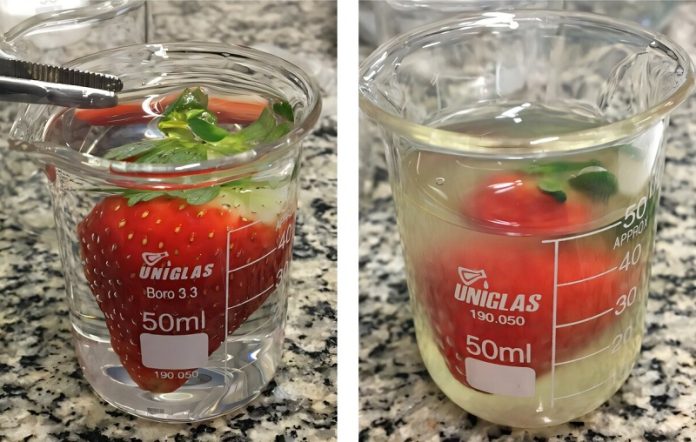
A new edible film made from pomegranate peel and squid shells can help strawberries stay fresh for much longer, according to scientists in Brazil.
This natural coating could double the shelf life of strawberries and prevent them from drying out or growing mold too quickly—all without changing their taste or smell.
The film was developed by researchers at the University of São Paulo (IQSC-USP), along with teams from EMBRAPA Instrumentation and the Federal University of São Carlos (UFSCar).
Their results were recently published in the journal Food Chemistry.
In tests, strawberries covered with the edible film stayed fresh for up to 12 days in the fridge. The coated berries took 6 to 8 days to show signs of mold, compared to just 4 days for uncoated ones. They also lost less water, keeping their texture better.
“By using this film, we were able to keep the fruit firmer, tastier, and smelling fresher for longer,” said Mirella Romanelli Vicente Bertolo, the study’s first author and a postdoctoral researcher at EMBRAPA.
The coating is made using two main ingredients: gelatin and chitosan, a natural substance found in the shells of sea creatures. But instead of using shrimp shells (which can cause allergies), the researchers used squid glia—an inner shell part of squids—so the film is safer for more people.
The film’s special power comes from antioxidants taken from pomegranate peels, which are usually thrown away. These antioxidants help stop the growth of microbes and slow down the fruit’s natural aging. The team used a special method to pull out 84% more antioxidants from the peel using a natural liquid called NADES (natural deep eutectic solvents).
“More than 40% of a pomegranate is just peel, and we wanted to turn that waste into something useful,” said Professor Stanislau Bogusz Junior, who supervised the project.
The strawberry was chosen as a test fruit because it is very delicate and spoils quickly. It has high moisture, a lot of sugars, and a low pH, making it the perfect target for mold and spoilage. If the film worked on strawberries, the researchers believe it could work on many other fruits as well.
Strawberries were dipped in the coating and stored in the fridge for 12 days. During that time, the coated fruit kept its color, firmness, aroma, and taste much better than uncoated strawberries. In fact, the coated berries preserved 40% more of the compounds responsible for their smell.
Taste tests confirmed that people didn’t notice any difference in flavor or appearance between the coated and uncoated fruit.
The team has filed a patent and hopes to license the technology to food companies. They estimate the coating would add just BRL 0.15 (about 3 cents USD) per fruit—an affordable price for longer-lasting strawberries.
“This is a small cost for fruit that stays fresh longer and reduces waste,” Bertolo said.
If you care about nutrition, please read studies about the harm of vitamin D deficiency, and Mediterranean diet may preserve brain volume in older adults.
For more health information, please see recent studies about foods to naturally lower high blood pressure, and a simple breakfast switch can help control type 2 diabetes.



